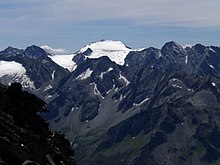Radio burner
Radio Brenner , later also Radio Brenner 1 and finally Südtirol 1 , was a private radio station from South Tyrol in Italy that targeted the southern Bavarian region over the main Alpine ridge using complex transmission technology . In this way, the ban on private radio stations in Germany , which was still in force at the time, could be circumvented. In Italy, however, private broadcasting was already allowed at the time. Due to its unconventional programming, Radio Brenner enjoyed comparatively great popularity.
history
In 1980 a consortium was formed with start-up capital of 8 million DM , according to other sources of around 5 million DM, in order to supply the Bavarian region with a private radio from South Tyrol. Radio Brenner International was initially set as the name for the radio station . Because of the likelihood of confusion with the sending also from South Tyrol Radio Bavaria International was allowed later the International on behalf gone, so the common name Radio burner was left. The first test broadcasts were made in early 1981, and continuous operation began in May of the same year.
After the first successes, a second program was planned, so that a 1 was added to the previous program . However, it stayed with Radio Brenner 1, a second program was not broadcast. Even the planned television program did not go beyond simple tests. In 1986 the name was changed to Südtirol 1 , then in 1990 for the last time for a few months in Radio Brenner Südtirol . With the release of private broadcasting in Germany in the meantime, the need to carry out broadcast operations from Italy was increasingly eliminated, so that the station was sold to the local radio station Radio Zirog in July 1991.
Location and technology
The studio for the program operation was in Sterzing , a small town in South Tyrol not far from the eponymous Brenner Pass . The broadcast to the north was initially from a transmitter near the summit of the Flatschspitze from an altitude of around 2500 m, around three kilometers south of the Brenner Pass on the Italian side. The transmission of the modulation signal from the radio station in Sterzing to the Flatschspitze took place via a converter on the Rosskopf via a radio link in the 13 GHz band.
The first test broadcasts used the 102.15 MHz frequency. The output power of the VHF transmitter was 10 kilowatts, the radiated power was around 400 kilowatts ERP . After Bayerischer Rundfunk had occupied the neighboring frequency of 102.3 MHz with its classic program Bayern 4 , a frequency change became necessary. 104.05 MHz was used as the new frequency for a longer period of time. In Munich, the reception was somewhat limited due to shadowing, but large parts of southern Bavaria could be reached. Individual reception reports even came from Stuttgart , Nuremberg and the former GDR . In May 1987 the move to the significantly higher and more favorably located Schwarzenstein took place . Thanks to the altitude of 3300 m, the reception in southern Germany has improved considerably. In 1989 the transmitter on the Schwarzenstein was destroyed by arson . The system was rebuilt, but continuous broadcasting was no longer successful. After several frequency changes, it was last broadcast again from the Flatschspitze until the end of the station in 1991.
program
The first broadcast manager and presenter was Bernd Kühl , other presenters included Waldemar Müller and Axel Ricken . The spontaneous jokes and the sometimes unplayed, chaotic, improvised moderation were unusual for the time. The style of the radio Brenner moderation was later imitated by some other radio stations and had a strong influence on the German radio comedy scene.
The music selection was a colorful mixture of current titles and oldies , supplemented by an Italian-language program and the popular request concert, long-running . Here, listeners could call and ask for titles that were then usually played immediately. The number of callers was so high that the telephone network in Sterzing was temporarily blocked.
Others
The current station Südtirol 1 has no relation to Radio Brenner.
literature
- Wolf-Dieter Roth : pirate station . 1st edition. Siebel, Verlag für Technik und Handwerk GmbH, Baden-Baden 2004, ISBN 3-88180-637-7 , p. 176-201 .
Web links
Individual evidence
- ↑ Radio Brenner versus Bavarian Radio - Wellenbrecher . In: Capital . Gruner + Jahr , September 1983, ISSN 0008-5847 , p. 221 ff .
- ↑ Michael Heysinger: Private broadcaster in South Tyrol: long-running hits from the Alps . In: Elo . Franzis-Verlag , December 1982, ISSN 0341-4175 , p. 44-47 .

